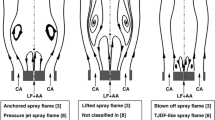Abstract
From the microgravity experiments on single fuel droplet combustion and on spark-ignited premixed flame in acoustic field, that have been done in this decade, secondary flow has been confirmed. The flow occurs only when combustion occurs and always in the direction to the neighboring node of velocity oscillation in standing acoustic field. This flow is thought to be driven by a kind of acoustic radiation force that arises from density non-uniformity due to combustion. According to the hypothesis, the driving force is expected to be very similar to buoyancy, being a volumetric force proportional to density difference. Since the mechanism tells that only the density difference due to combustion is the requirements for the occurrence of the secondary flow, a simpler system is employed for the hypothesis validation. A hot wire in a standing acoustic field gives a local temperature rise and the secondary flow is successfully reproduced. To avoid buoyancy that covers the radiation force, microgravity conditions are used. Through direct- and modeled numerical simulations and with drop tower experiments, the validity of the hypothesis is checked out. As a result, the supposed radiation force is found to be able to explain well the characteristics of the secondary flow. It is found that adding an acoustic radiation force term determined from acoustic parameters into conventional CFD calculation, one can sufficiently reproduce and predicts the behavior of the secondary flow numerically.
Similar content being viewed by others
References
Dattarajan, S., Lutomirski, A., Lobbia, R., Smith, O.I., Karagozian, A.R.: Acoustic excitation of droplet combustion in microgravity and normal gravity. Combust. Flame 144, 299–317 (2006)
Gor’kov, L.P.: On the forces acting on a small particle in an acoustical field in an ideal fluid. Sov. Phys. Dokl. 6(9), 773–775 (1962)
Lieuwen, T.C., Yang, V.: Combustion instabilities in gas turbine engines. Prog. Astronaut. Aeronaut. 210, 3 (2005)
Morgan, V.T.: The overall convection heat transfer from smooth circular cylinders. Advances in Heat Transfer, vol. 11, pp. 199–264. Academic Press, New York (1975)
Nagata, H., Kim, H.M., Sato, J., Kono, M.: An experimental and numerical investigation on the hot surface ignition of premixed gases under microgravity conditions. In: Twenty-Fifth Symposium (International) on Combustion/The Combustion Institute, pp. 1719–1725 (1994)
Nyborg, W.L.: Radiation pressure on a small rigid sphere. J. Acoust. Soc. Am. 42(5), 947–952 (1967)
Okai, K., Moriue, O., Arai, M., Tsue, M., Kono, M., Sato, J., Dietrich, D.L., Williams, F.A.: Combustion of single droplets and droplet pairs in a vibrating field under microgravity. Proc. Combust. Inst. 28, 977–983 (2000)
Rayleigh, J.W.S.: The Theory of Sound. Macmillan, London (1896)
Tanabe, M., Morita, T., Aoki, K., Satoh, K., Fujimori, T., Sato, J.: Influence of standing sound waves on droplet combustion. Proc. Combust. Inst. 28, 1007–1013 (2000)
Tanabe, M., Kuwahara, T., Satoh, K., Fujimori, T., Sato, J., Kono, M.: Droplet combustion in standing sound waves. Proc. Combust. Inst. 30, 1957–1964 (2005)
Yano, T., Takahashi, K., Kuwahara, T., Tanabe, M.: Influence of acoustic perturbation and acoustically induced thermal convection on premixed flame propagation. Microgravity Sci. Technol. 22, 155–161 (2010)
Author information
Authors and Affiliations
Corresponding author
Rights and permissions
About this article
Cite this article
Tanabe, M. Drop Tower Experiments and Numerical Modeling on the Combustion-Induced Secondary Flow in Standing Acoustic Fields. Microgravity Sci. Technol. 22, 507–515 (2010). https://doi.org/10.1007/s12217-010-9225-6
Received:
Accepted:
Published:
Issue Date:
DOI: https://doi.org/10.1007/s12217-010-9225-6




